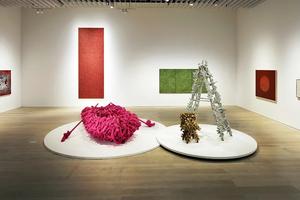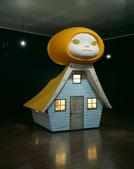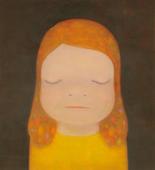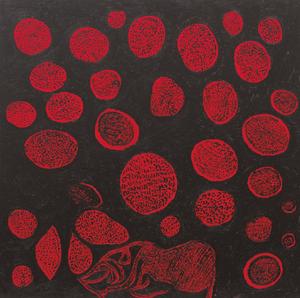Tokyo’s Mori Art Museum hosts an exhibition of a sextet who made a profound impact on Japanese contemporary art, marking a major cultural and aesthetic moment
 Takashi Murakami, Cherry Blossoms Fujiyama Japan, 2020, acrylic on canvas, 500 x 2,125cm.
Takashi Murakami, Cherry Blossoms Fujiyama Japan, 2020, acrylic on canvas, 500 x 2,125cm.
This year’s COVID-19 pandemic has entirely rewritten and rescheduled so much of the cultural calendar, it’s a rare miracle when anything appears in the real world unscathed. All of which makes Tokyo’s Mori Art Museum’s (MAM) worldly, ambitious and audacious Stars: Six Contemporary Artists From Japan to the World (until January 3, 2021) a must-attend show and major art moment. Originally planned for April but postponed and now just reopened, MAM’s show highlights six globally influential artists – Yoshitomo Nara, Yayoi Kusama, Takashi Murakami, Hiroshi Sugimoto, Lee Ufan and Tatsuo Miyajima – whose careers after the Second World War propelled them beyond the confines of Japan and across the generations.
Tracing the artists’ journeys from their earliest to their most recent works, Stars explores how the practice of each artist has been evaluated in the global context. It touches upon their pursuit of universal issues that transcend nationality and culture, traditions and aesthetics, and technology and subculture, all the while keeping in mind the social, cultural and economic aspects particular to Japan.
 Yayoi Kusama, installation view of Stars: Six Contemporary Artists from Japan to the World, Mori Art Museum, Tokyo, 2020; photo: Takayama Kozo.
Yayoi Kusama, installation view of Stars: Six Contemporary Artists from Japan to the World, Mori Art Museum, Tokyo, 2020; photo: Takayama Kozo.
Intriguingly, the exhibition also presents archival materials related to the major Japanese contemporary art shows staged internationally from the 1950s to the present, providing original archival material such as installation photographs and exhibition reviews. This shows how the organisers and curators of Stars endeavoured to express the concept of “Japan”, and how such attempts were received (some critiques suggest it was far from plain sailing) in the process of unravelling the history of Japanese contemporary art’s acceptance in the wider world. As such, for aficionados and amateurs alike, we learn what distinguishes each artist’s approach.
 Takashi Murakami, Miss Ko²; 1996–2011; lacquer paint on plastics, fibreglass and iron with corian base, 181 x 61 x 102.5cm.
Takashi Murakami, Miss Ko²; 1996–2011; lacquer paint on plastics, fibreglass and iron with corian base, 181 x 61 x 102.5cm.
Murakami’s “Superflat” theory reimagines the sources of traditional Japanese painting and contemporary art through the visual logic of anime and manga. With its richly colorful ornamentation, peculiar deformations, and highly playful imagery, his work expresses a spirit that has pulsed beneath the surface of Japanese culture since the “eccentric” painters of the Edo era through to the contemporary. Murakami’s Cherry Blossoms Fujiyama Japan (2020), created especially for Stars, is a playful work that ironically depicts painting as a tourist attraction.
 Yoshitomo Nara, Voyage of the Moon (Resting Moon) / Voyage of the Moon, 2006, mixed media, 476 x 354 x 495cm; cooperation provided by Graf; collection: 21st Century Museum of Contemporary Art, Kanazawa; photo: Nakamichi Atsushi / Nacása & Partners
Yoshitomo Nara, Voyage of the Moon (Resting Moon) / Voyage of the Moon, 2006, mixed media, 476 x 354 x 495cm; cooperation provided by Graf; collection: 21st Century Museum of Contemporary Art, Kanazawa; photo: Nakamichi Atsushi / Nacása & Partners
Yoshitomo Nara is known for using children and animals in simplistic, abstract and misshapen forms, across conflicting dispositions from innocence to cruelty that inspire the imagination of the viewer. Nara’s solitary protagonists represent those living on society’s margins, but with their depictions of the whereabouts of the soul, they take on an almost primitive form that transcends time. Fifteen of the artist’s early works from the 1980s are being shown for the first time as well as a new piece, Miss Moonlight.
 Yoshitomo Nara, Miss Moonlight, 2020, acrylic on canvas, 220 x 195cm; photo: Kioku Keizo.
Yoshitomo Nara, Miss Moonlight, 2020, acrylic on canvas, 220 x 195cm; photo: Kioku Keizo.
Fusing elements of Buddhist thought and technology, Tatsuo Miyajima tackles the universal notion of time by way of installations and sculptures that use digital LED counters displaying changing numbers from one to nine. Since 2017, he has been working continuously on Sea of Time – Tohoku, an attempt to install 3,000 LED counters in northeast Japan’s Tohoku region, as tribute to the victims of the Great East Japan Earthquake of 2011. Stars presents a new work featuring all the digital counters made to date for Sea of Time – Tohoku.
 Lee Ufan, Dialogue, 2020, acrylic on canvas, 291 x 218cm.
Lee Ufan, Dialogue, 2020, acrylic on canvas, 291 x 218cm.
Renowned photographer and contemporary artist Hiroshi Sugimoto moved to New York in 1974. The first work in his “Diorama” series, Polar Bear (1976), emerged from Sugimoto’s experience of a kind of illusion at the American Museum of Natural History, whereby a diorama seemed to be alive when he viewed it with one eye covered. His debut film, The Garden of Time (2020), showing at Stars, captures the changing seasons in remarkable detail at Enoura Observatory in Kanagawa.
Lee Ufan moved to Japan 20 years after being born in South Korea in 1936 and has been a resident since. He was one of the pioneers of “Mono-ha”, a sculptural movement that rejected the idea of production and presented objects and materials as they were born. As Mono-ha has come to be reappraised at a global level, there is a rising tide of interest in the practices that have spanned Lee’s 50-year career.
 Yayoi Kusama, Splendor of Numerous Loves, 2019, acrylic on canvas, 100.3 x 100.3cm; collection: T Party Ltd.
Yayoi Kusama, Splendor of Numerous Loves, 2019, acrylic on canvas, 100.3 x 100.3cm; collection: T Party Ltd.
Yayoi Kusama’s signature pumpkins, polka dots, infinity rooms, nets and mesh patterns have seen the 91-year-old artist transcend pop art and minimalism. Kusama moved to the US in 1957, and gained notoriety in fashion and for her participation in anti-war protests before returning to Japan in 1973. Since the 1990s, she has won universal acclaim with her large-scale exhibitions influenced by hallucinations and obsessions that have persisted since her youth, and now has her own museum in Tokyo.
“The global pandemic highlights the vulnerability of our social and economic structures,” declares MAM in a statement. “At this moment in history, as well as raising some fundamental questions about the essential role of art, how we define artistic success, and where we might find the ‘world’ we seek, the output of these six top artists will doubtless offer some powerful messages suffused with inspiration for the post-corona age.” We couldn’t agree more. Mingle with the Stars and indulge this aesthetic engine of change as you marvel at Japan’s artistic and cultural might. by


